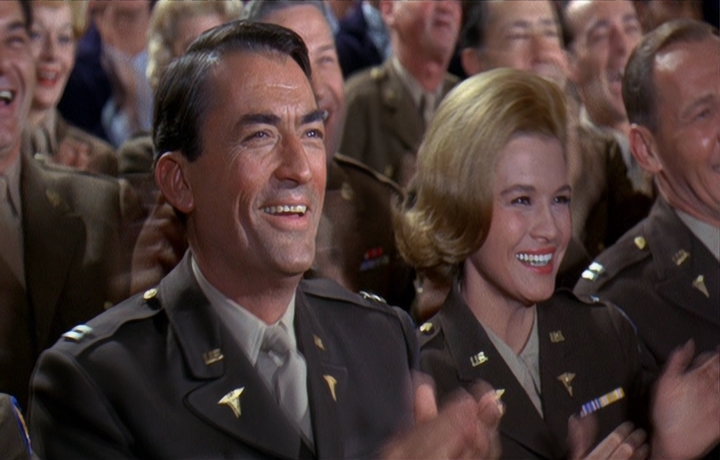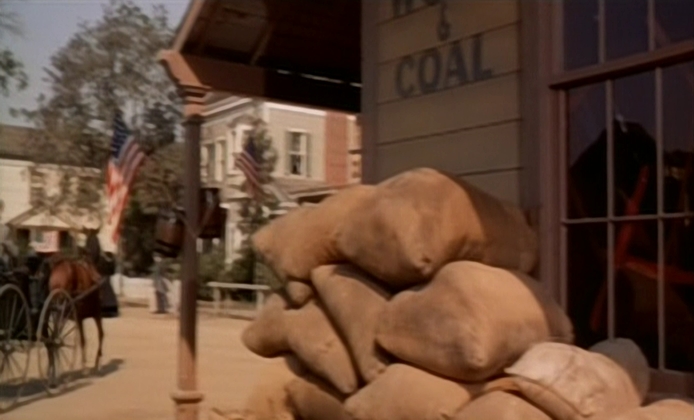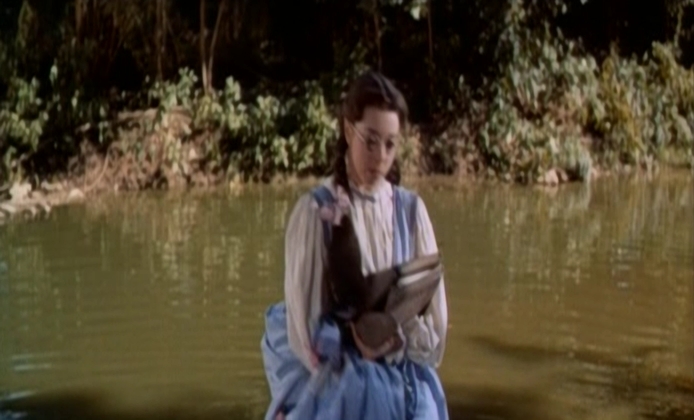{ Original }
{ After Using QTGMC }
This blending frame is very stubborn and even QTGMC couldn't decimate it completely.
So, may I ask what will be the best solution to deal with this kind of fast-moving scene?
BTW, comparing to TIVTC, QTGMC is more efficient. But, as far as I was concerned, it do some frame interpolation which TIVTC doesn't do. And for some sources which are not "really interlaced", I've been told to follow such rules:
(1) For PAL interlace: yadifmod(edeint=nnedi2())
(2) With NTSC DVDs, if they are 100% film: tfm(pp=0).tdecimate()
(3) If they are not 100% film (for example, 99.99% film or less), choose from these two for the more efficient one:
tfm().tdecimate() or tfm(order=1).tdecimate()
Now, since I knew QTGMC was efficient but slow, I want to use it all the time without caring about the percentage number given by the d2v file. Is this a good solution? Could I use the following code all the time to deal with interlacing and blending (Obviously, in this example, QTGMC is not enough)?
WILL QTGMC DO HARM TO THE SOURCE? (That is to say, apart from decimating interlacing and blending, will it do something harmful to the source other than restoring?)
Code:AssumeTFF() Import("D:\Program Files\Megui\tools\avisynth_plugin\QTGMC-3.32.avs") QTGMC() Merge(SelectEven(),SelectOdd())
Try StreamFab Downloader and download from Netflix, Amazon, Youtube! Or Try DVDFab and copy Blu-rays! or rip iTunes movies!
+ Reply to Thread
Results 1 to 30 of 49
Thread
-
-
This is another movie, needless to say it's another totally different source. But the situation is resembled.
Take a look at Gregory Peck's action.
{ Before }

{ After }

Last edited by xuguang_he; 21st Apr 2013 at 08:04.
-
Another comparsion. (Before & After using QTGMC)
{ Before }

{ After }

Last edited by xuguang_he; 21st Apr 2013 at 08:05.
-
I felt that, sometimes, QTGMC makes the source's color more thick and the picture looks a bit like a oil painting, which is not to my like.
{ Before }

{ After }

Or maybe it's due to the fuzzy original source.
Also, take a look at the walking person in background. The original source was blended a bit, but after QTGMC' filtering function, it has been decimate perfectly.
Last edited by xuguang_he; 21st Apr 2013 at 07:56.
-
Is this the best solution for anti-aliasing?Code:
EEDI2().Spline36Resize(width,height).turnleft().EEDI2().Spline36Resize(height,width).turnright()

-
Sometimes you need to apply different settings to different sections, different filter, or different approach entirely . QTGMC is a temporal filter and known to cause blends
There is probably misinterpretation in "efficient"BTW, comparing to TIVTC, QTGMC is more efficient.
1) These are not comparable functions, they have different purposes (field matching vs. deinterlacing)
2) Efficiency deals with measuring inputs and outputs e.g. a cost to get a certain effect
Again, these aren't comparable functions. Apples to oranges.But, as far as I was concerned, it do some frame interpolation which TIVTC doesn't do. And for some sources which are not "really interlaced", I've been told to follow such rules:
But you can tell TIVTC to use QTGMC during comb detection with the clip2 parameter. Have a look the instructions
Not a good idea
Now, since I knew QTGMC was efficient but slow, I want to use it all the time without caring about the percentage number given by the d2v file. Is this a good solution? Could I use the following code all the time to deal with interlacing and blending (Obviously, in this example, QTGMC is not enough)?
Yes it alters the original source, doesn't retain original fields. It applies other processing like denoising and sharpening. At default strengths, often too high for most sources (think "oil painting" look). All the settings are adjustable - read the instructions. Even for deblending (srestore) , it can cause more problems than other deinterlacers (but other deinterlacers may leave more deinterlacing artifacts behind)
WILL QTGMC DO HARM TO THE SOURCE? (That is to say, apart from decimating interlacing and blending, will it do something harmful to the source other than restoring?) -
-
Apart from QTGMC, there seems no perfect solution to this source:
https://forum.videohelp.com/threads/355377-Interlacing-problem
But QTGMC do sth else that give the source a "oil painting" look while it also make the small interlacing gone. (TIVTC is not efficient when dealing with this source) -
And may I ask how to apply different settings to one source? (Searching through the forum, I've learnt to use Trim(), but the preview in MeGUI seems miserable, the ending of the film comes to the middle and the length of the film increased to 5 hours!!! Totally horrible.)Sometimes you need to apply different settings to different sections, different filter, or different approach entirely . QTGMC is a temporal filter and known to cause blends
I'm ripping movies, so there is audio included. Is Trim() still available for this kind of situation?Last edited by xuguang_he; 21st Apr 2013 at 09:13.
-
But apparently, in some of the examples I gave above, QTGMC decimate the blends. How to explain it may I ask?Sometimes you need to apply different settings to different sections, different filter, or different approach entirely . QTGMC is a temporal filter and known to cause blends
-
To remove field blending from PAL/NTSC conversions use:
orCode:Yadif(mode=1) SRestore()
Be sure the field order is set correctly first.Code:QTGMC() SRestore()
As usual, you should post a short sample of your source. -
So, is there any solution that could both decimate the interlacing artifacts completely and not to make the picture "oil painting" look?
-
Search on how to apply different filters to different sections, there are many approaches and they are discussed in great detail with examples. e.g trim() with aligned splice, replaceframessimple() , clipclop() to name a few. The lenghts are unchanged when you use them properly
Trim works on audio as well , if you include in your script e.g. audiodub()
This would return frames 500-1000 with audioCode:vid=mpeg2source() aud=nicac3source() audiodub(vid,aud) trim(500,1000)
e..g
This would apply filter1 to 0-100, filter2 to 100-end, same length as originalCode:orig=whateversource() orig trim(0,100) filter1() a=last orig trim(100,0) filter2() b=last a++b
-
-
I've used DGIndex to cut the clip, but up till now, I could only cut out the first few seconds of a VOB file by demuxing it for a few seconds and exit the program as soon as possible (Then I get a m2v file of a VOB, but just the first few seconds of it). How could I just cut out a few frames which I intended to cut? -
https://forum.videohelp.com/threads/355377-Interlacing-problem
The Sample is cut from the same source as the sample posted in this thread. -
-
-
Here it is.
Apparently the original source is not blended, but somehow QTGMC plus SRestore made it so. -
But after using QTGMC, it do cause some new blended frames which original source don't have. This one is not included, but there are others.
-
-
I'll post it tomorrow, now is late night in China, sleep is the first matter...

-
Here it is, the clip, which contained both blended and interlaced artifacts, and couldn't be decimate by srestore or deblend.
-
There is no field blending in that clip. It's the same as the other clips but has a phase shift in some frames (some frames contain fields from two different film frames). Using Merge(SelectEven(),SelectOdd()) after QTGMC() is causing the blended frames when the two fields are out of phase.
For example, when using:
frames 0 to 10 are in phase and show no blending artifacts. The rest of the frames are out of phase and show blending artifacts.Code:AssumeTFF() QTGMC() Merge(SelectEven(),SelectOdd())
Using:
shows frames 0 to 9 with blending, the rest with no blending.Code:AssumeTFF() QTGMC() Trim(1,0) Merge(SelectEven(),SelectOdd())
An automated way around this might be to use TFM() first, then follow with QTGMC() and Merge(...). It worked for this clip but could cause problems with others.
Code:AssumeTFF() TFM() QTGMC() Merge(SelectEven(),SelectOdd())
-
looks fine hereCode:
A2 = last A2 = A2.QTGMC(Preset="slow", FPSDivisor=2) TDeint(edeint=A2,emask=TMM(mode=0),slow=2,chroma=true,MI=80,full=false,cthresh=9)
-
Similar Threads
-
frame blending caused by MDegrain
By unclescoob in forum RestorationReplies: 16Last Post: 22nd Apr 2013, 01:53 -
VirtualDub Filter Blending
By sambat in forum EditingReplies: 4Last Post: 6th Sep 2009, 14:07 -
Sporadic frame blending in PAL DVD of Soviet-era film
By chipsndukes in forum RestorationReplies: 3Last Post: 19th Apr 2009, 22:42 -
frame blending with mencoder
By spaceshotfever in forum LinuxReplies: 0Last Post: 14th Feb 2009, 12:46 -
Image Blending
By keithnut in forum EditingReplies: 4Last Post: 15th Jun 2008, 11:36





 Quote
Quote






